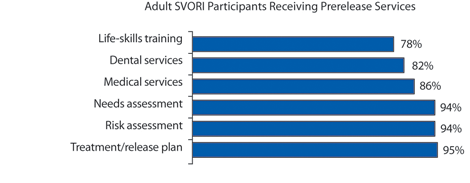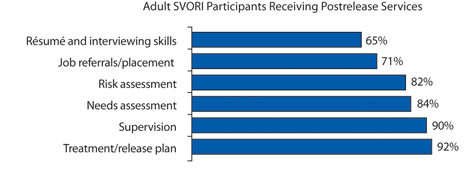Key demographics were recently released from a study of reentry programs under the Serious and Violent Offender Reentry Initiative (SVORI)—a Federal effort to help States use their correctional resources to reduce recidivism.[1] Aimed at increasing public safety, SVORI is an unprecedented national response to the criminal justice, employment, education, health, and housing challenges that convicted adults and juveniles face when they return to the community.
RTI International, a nonprofit research group, and the Urban Institute, a nonpartisan economic and social policy research organization, are conducting a 5-year evaluation of the effectiveness of the SVORI programs. In the National Institute of Justice-funded evaluation, researchers interviewed prisoners at 16 sites, asking them shortly before they were released what services they felt they would need. Here is a summary of the demographics and responses of the SVORI group (a sample of 935 men who received SVORI services) and the comparison group (923 men who did not receive SVORI services).[2]
Who Are the SVORI Men?
More than half of the men in the SVORI group are African American, and nearly one-third are Caucasian.[3] The majority of the SVORI group are neither married nor in a steady relationship. The average age of the men is 29. Sixty percent are fathers of minor children, and nearly half of them reported having primary care responsibilities.
Nine out of 10 men in the SVORI group reported having a job at some point in their lifetime, and nearly two-thirds said they were employed during the 6 months before their incarceration. They typically held blue-collar jobs, serving as laborers, service workers, equipment operators, and skilled craftspeople.
Nearly half reported that they had supported themselves in part through illegal activities, and more than two-thirds reported perpetrating violence during the 6 months before they were incarcerated. Eighty-three percent served prior prison terms. The majority of the group reported having family members and friends who had been convicted of a crime or had problems with drugs and alcohol.
The SVORI Men Define Their Needs
Part of the evaluation of the SVORI programs is based on prisoners’ responses to questions about the services they need after they are released from prison. The most commonly reported reentry needs were more education, general financial assistance, a driver’s license, job training, and employment.
Nearly three-quarters of the SVORI group reported needing transportation assistance and better money-management skills. More than half said they needed some of the most basic and immediate needs—food, clothing, and a place to live—along with basic identification (birth certificate, Social Security card, and photo ID card) and financial assistance. Those who had minor children also reported a need for parenting classes and child care, help with child support payments, and help resolving custody issues.
When asked what health services they needed upon release, three-quarters identified health care insurance and more than half identified medical treatment. It is important to keep in mind that many reported needs are intertwined. For example, when a former prisoner applies for medical insurance or treatment, he is also likely to need identification and possibly transportation.
The majority of the SVORI group seemed to recognize some aspect of their own behavior that they need to change to improve their lives after they are released. Almost two-thirds reported needing to work on their personal relationships, and more than half said they needed a mentor and spiritual or religious assistance. One-third reported needing anger management training.
Over the next 2 years, additional findings will be released. These will be based on interviews with the SVORI group and the comparison group at 3 months, 9 months, and 15 months postrelease. The interviews will include drug testing at the 3- and 15-month marks, which will offer critical data not only on postrelease drug use, but also on the consistency of self-reported information. Additional analyses will examine recidivism and other outcomes at 12 and 24 months postrelease.
NCJ 219609
Charts
SVORI GROUP DEMOGRAPHIC HIGHLIGHTS
- Average age 29 years
- 56% African American
- 32% Caucasian
- 4% Hispanic
- 83% served prior prison terms
- 52% had been incarcerated in juvenile correctional facility
- 62% completed high school or GED
- 60% with children under age 18
- Of those with minor children, 49% have primary care responsibilities of children
- 37% in a steady intimate relationship
- 8% married
| Education/Employment Experience | % of Respondents |
|---|---|
| Ever held a job | 89 |
| Held a job during 6 months pre-prison | 64 |
| High school graduate or GED | 62 |
| Expect to return to a previous job | 56 |
| Never held a job for more than 1 year | 42 |
| Method of Support | % of Respondents |
|---|---|
| Partly through illegal activities | 45 |
| Mostly through illegal activities | 39 |
| Help from family | 32 |
| Help from friends | 18 |
| Experience With Violence | % of Respondents |
|---|---|
| Perpetrated violence during 6 months pre-prison | 69 |
| Victim of violence during 6 months pre-prison | 59 |
| Victim of violence during incarceration | 56 |
| Friends/Family Criminal Behavior | % of Respondents |
|---|---|
| Friends have been convicted of a crime or incarcerated | 84 |
| Friends have drug or alcohol problems | 82 |
| Family members have been convicted of a crime or incarcerated | 78 |
| Family members have problems with drugs or alcohol | 72 |
MOST REQUESTED REENTRY NEEDS
- 94% More education
- 86% General financial assistance
- 83% Driver’s license
- 82% Job training
- 80% Employment
| Health Service | % of Respondents |
|---|---|
| Health care insurance | 76 |
| Medical treatment | 57 |
| Alcohol or substance abuse treatment | 38 |
| Mental health treatment | 23 |
| Family Service | % of Respondents With Minor Children |
|---|---|
| Parenting classes | 61 |
| Help with child support payments | 45 |
| Child care | 40 |
| Help resolving child custody issues | 36 |
| Service | % of Respondents |
|---|---|
| Transportation assistance | 73 |
| Money-management skills | 71 |
| Access to food or clothing banks | 62 |
| Identification (e.g., birth certificate) | 56 |
| Financial assistance from government | 53 |
| A place to live | 52 |
| Legal assistance | 46 |
| Attitude/Behavior Support | % of Respondents |
|---|---|
| Change attitude about criminal behavior | 65 |
| Improve personal relationships | 64 |
| Mentoring | 60 |
| Spiritual or religious assistance | 52 |
| Anger management | 36 |
Sidebar
WHAT DO THE SVORI PROGRAMS OFFER?
SVORI funding supports a three-phase service continuum that focuses on reentry preparation: (1) just prior to release from prison, (2) during the first few months postrelease, and (3) for several years postrelease as participants take on more productive and independent roles in the community. There are 89 adult and juvenile SVORI programs, which offer such services as life-skills training, dental and medical services, needs and risk assessments, treatment and release plans, and job placement.
The following charts, based on a survey of SVORI program directors in 2005, show the percentage of adult SVORI participants that received particular types of services in prison (prerelease) and after they were released.
About This Article
This article appeared in NIJ Journal Issue 258, October 2007.




